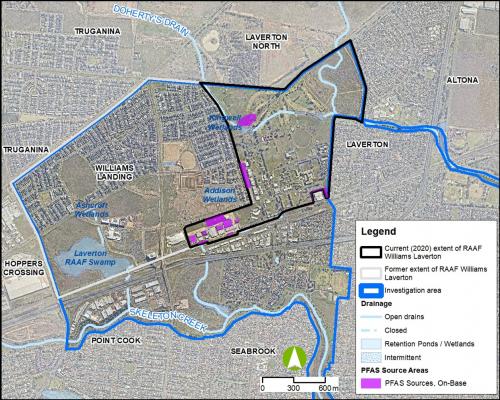Goya Dmytryshchak
The Department of Defence has confirmed off-site contamination from chemicals found in firefighting foams used on the RAAF Base Williams at Laverton, including in groundwater, world-listed Cheetham Wetlands and waterways discharging into Port Phillip Bay.
It will now investigate the risk to residents of Williams Landing and nearby from eating home-grown fruit, vegetables, and chicken eggs.
It will also look at the risk from eating fish and eels caught at Skeleton Creek and Sanctuary Lakes.
A federal Department of Health fact sheet states there is “no conclusive evidence” that per- and poly-fluoroalkyl substances (PFAS) cause cancer although some studies had shown a possible link.
Luke McLeod, assistant secretary of the department’s PFAS Investigation and Management Program said Defence was not a health authority and relied on evidence that exposure to PFAS be minimised as “important health effects for individuals cannot be ruled out based on the current evidence”.
He said a survey of how the community near the Laverton base used or had used bore and surface water “did not identify any users of groundwater for drinking water purposes and the general groundwater quality is not suitable for drinking water or irrigating home-grown produce, due to high levels of salinity”.
“The base and surrounding properties are serviced by mains water supplied by City West Water,” he said.
“This is important, as the primary route of exposure to PFAS in humans occurs through drinking-impacted water or through consumption of food that has been exposed to impacted water or soil.”
Defence started using foams containing PFAS chemicals in the 1970s for fighting high-intensity liquid fuel fires.
In 2003, the National Industrial Chemicals Notification and Assessment Scheme recommended its use be restricted and, in 2004, Defence started phasing out its use.
In 1999, the runways associated with RAAF Base Williams were decommissioned and the airfield sold off for urban redevelopment in what is now known as Williams Landing.
A report commissioned by Defence and released this month found the chemicals had “migrated” off-base and recommends investigation into the risk to residents of larger allotments in Williams Landing and surrounds.
A Defence spokesperson on Friday said the next step in the investigation was to undertake a human health and ecological risk assessment.
The spokesperson said Defence would investigate:
-The potential for wildlife to be exposed to PFAS in Skeleton Creek, Laverton RAAF Swamp [Williams Landing natural wetlands], Sanctuary Lakes and Cheetham Wetlands;
– The potential for people to be exposed to PFAS by consuming fish and eels caught at Skeleton Creek and Sanctuary Lakes;
– The potential for people to be exposed to PFAS through some uses of soil at Williams Landing.
“Specifically, Defence will further assess the potential exposure pathway via consumption of home-grown produce – fruits, vegetables and chicken eggs,” the spokesperson said.
“A preliminary assessment of PFAS in soil in the area indicates that the exposure risk is low and there is no need for people to change the way they use their land.”








